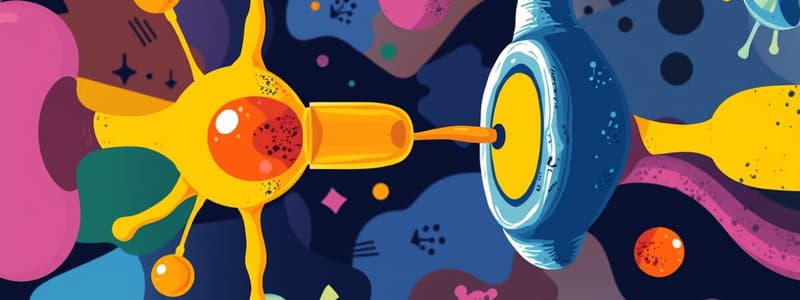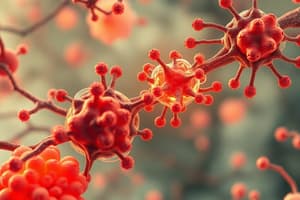Podcast
Questions and Answers
Which component of the drug receptor directly recognizes and binds the drug molecule?
Which component of the drug receptor directly recognizes and binds the drug molecule?
- Transducer mechanism
- Amplification mechanism
- Recognition site (correct)
- Guanine nucleotide binding
What is the main role of the transducer mechanism within a drug receptor?
What is the main role of the transducer mechanism within a drug receptor?
- To permanently modify the drug molecule
- To initiate immune responses
- To translate binding into biochemical changes (correct)
- To directly alter gene expression
How does the interaction between a drug and its receptor typically differ from that of an enzyme and its substrate?
How does the interaction between a drug and its receptor typically differ from that of an enzyme and its substrate?
- The drug binds covalently to the receptor
- The drug-receptor interaction is usually irreversible
- The drug molecule is not permanently changed (correct)
- The drug permanently modifies the receptor
What effect can the alteration resulting from receptor interaction have on cellular function?
What effect can the alteration resulting from receptor interaction have on cellular function?
Which statement best describes the binding forces between a drug and its receptor?
Which statement best describes the binding forces between a drug and its receptor?
What type of receptors allow ions to flow depending on the receptor activated?
What type of receptors allow ions to flow depending on the receptor activated?
Which element of the drug receptor system contributes to amplifying the cellular response?
Which element of the drug receptor system contributes to amplifying the cellular response?
What is a key characteristic of the drug-receptor interaction compared to enzyme-substrate interactions?
What is a key characteristic of the drug-receptor interaction compared to enzyme-substrate interactions?
What does the presence of specific sites of interaction in cells indicate about the potency of certain drugs?
What does the presence of specific sites of interaction in cells indicate about the potency of certain drugs?
Which statement about stereoisomers is true?
Which statement about stereoisomers is true?
What is the significance of the potency of lysergic acid diethylamide (LSD) in very small doses?
What is the significance of the potency of lysergic acid diethylamide (LSD) in very small doses?
Why is dextrorphan sold over the counter, while levorphanol is not?
Why is dextrorphan sold over the counter, while levorphanol is not?
How do norepinephrine and epinephrine differ in their biological functions?
How do norepinephrine and epinephrine differ in their biological functions?
What allows lysergic acid diethylamide (LSD) to produce profound effects despite low availability to nerve cells?
What allows lysergic acid diethylamide (LSD) to produce profound effects despite low availability to nerve cells?
What is a primary reason that dextrorphan is considered weak in comparison to levorphanol?
What is a primary reason that dextrorphan is considered weak in comparison to levorphanol?
Which statement best explains the role of receptors in drug interaction?
Which statement best explains the role of receptors in drug interaction?
What is the primary characteristic of a partial agonist?
What is the primary characteristic of a partial agonist?
Which term describes the ability of a drug to activate intracellular proteins?
Which term describes the ability of a drug to activate intracellular proteins?
How is efficacy best defined in pharmacodynamics?
How is efficacy best defined in pharmacodynamics?
Which statement about drug-receptor interactions is incorrect?
Which statement about drug-receptor interactions is incorrect?
What does the term 'potency' refer to in drug pharmacology?
What does the term 'potency' refer to in drug pharmacology?
Which of the following statements correctly describes affinity in pharmacodynamics?
Which of the following statements correctly describes affinity in pharmacodynamics?
What primarily influences the biochemical events that occur after receptor activation?
What primarily influences the biochemical events that occur after receptor activation?
What distinguishes an antagonist in the context of drug efficacy?
What distinguishes an antagonist in the context of drug efficacy?
What is the primary effect of acetylcholine binding to the nicotinic cholinergic receptor on skeletal muscle?
What is the primary effect of acetylcholine binding to the nicotinic cholinergic receptor on skeletal muscle?
Which receptors are characterized by having a peptide chain that spans the cell membrane multiple times?
Which receptors are characterized by having a peptide chain that spans the cell membrane multiple times?
In neurotransmitter-receptor interactions, which factor most influences the receptor's function?
In neurotransmitter-receptor interactions, which factor most influences the receptor's function?
What role do G-proteins play in the function of metabotropic receptors?
What role do G-proteins play in the function of metabotropic receptors?
What does the ED50 represent in pharmacology?
What does the ED50 represent in pharmacology?
How does a receptor with 7 membrane-spanning domains differ from others?
How does a receptor with 7 membrane-spanning domains differ from others?
How is the therapeutic window of a drug calculated?
How is the therapeutic window of a drug calculated?
What is one key characteristic of the nicotinic cholinergic receptor compared to muscarinic receptors?
What is one key characteristic of the nicotinic cholinergic receptor compared to muscarinic receptors?
What does the term TD50 refer to?
What does the term TD50 refer to?
What type of ions primarily enter skeletal muscle cells when the nicotinic cholinergic receptor is activated?
What type of ions primarily enter skeletal muscle cells when the nicotinic cholinergic receptor is activated?
Which of the following statements about therapeutic index is correct?
Which of the following statements about therapeutic index is correct?
Which intracellular system is NOT typically coupled with G-proteins?
Which intracellular system is NOT typically coupled with G-proteins?
What does a cumulative frequency distribution curve provide?
What does a cumulative frequency distribution curve provide?
If the ED50 is 10 mg/kg and the TD50 is 100 mg/kg, what is the therapeutic window?
If the ED50 is 10 mg/kg and the TD50 is 100 mg/kg, what is the therapeutic window?
Which of the following is NOT a type of dose referenced in pharmacology?
Which of the following is NOT a type of dose referenced in pharmacology?
What effect does a higher TD50 relative to ED50 indicate about a drug?
What effect does a higher TD50 relative to ED50 indicate about a drug?
Flashcards are hidden until you start studying
Study Notes
Drug-Receptor Interactions
- Drug binding is typically reversible due to weak forces, unlike permanent changes in enzyme-substrate interactions.
Receptor Components
- Drug receptors comprise three main components: recognition site (binds drug), transducer mechanism (converts binding to biochemical change), and amplification mechanism (modifies cellular function).
- Reactions can be excitatory (increase cell function) or inhibitory (decrease cell function).
Types of Agonists
- Partial agonists bind to receptors but can only induce a partial response, resulting in reduced efficacy.
Key Definitions
- Affinity: The attraction of a drug to its receptor.
- Intrinsic Activity: The ability to activate intracellular processes.
- Efficacy: The drug's capacity to produce a response on its own; antagonists have no efficacy.
- Potency: The concentration of a drug required to produce or block a response.
Receptor Characteristics
- Receptors are macromolecules in plasma membranes or cytoplasm that interact with endogenous (neurotransmitters, hormones) and exogenous substances (drugs).
- Different classes of hormones act on specific types of receptors: neurotransmitters on cell surface receptors, steroid hormones on intracellular receptors.
Drug Effectiveness
- Extreme drug potency indicates specific interaction sites within cells that amplify effects, demonstrated by small doses of drugs like LSD producing substantial biological impacts.
- Similar molecules can create analogous effects, highlighting specific structural interactions (e.g., norepinephrine and epinephrine).
- Stereoisomer effects vary; only one form may effectively bind to a receptor, exemplified by dextrorphan vs. levorphanol.
Mechanism of Action
- Drug-receptor binding alters receptor conformation, allowing ion flow across the membrane (e.g., nicotinic cholinergic receptors open ion channels upon acetylcholine binding).
- Not all cell types express every receptor, contributing to the diversity of pharmacological responses.
Second Messenger Receptors
- Second messenger receptors feature integral membrane proteins with peptide chains, potentially spanning the membrane multiple times or once.
- They interact with G proteins and link to intracellular amplification systems like adenylate cyclase, impacting cell signaling.
Dose-Response Relationship
- The median effective dose (ED50) indicates the dose causing a desired effect in 50% of the population.
- The median toxic dose (TD50) and median lethal dose (LD50) correspond to specific levels of toxicity or death.
- The therapeutic window, calculated as TD50/ED50, reveals the drug's safety margin.
Safety Evaluation
- Quantal dose-response curves help compare therapeutic effects with toxic effects, establishing a drug's therapeutic index, the ratio of LD50 to ED50, indicative of relative safety.
Studying That Suits You
Use AI to generate personalized quizzes and flashcards to suit your learning preferences.




